With a lack of space for a large number of seedlings on window sills and balconies, an economical way of growing seedlings of vegetables and flowers in diapers has been invented, since it only needs cellophane bags and a little soil. He gained particular popularity in the suburbs, so he began to be called the Moscow method. This is also true in small apartments with narrow window sills.
Content
The benefits of growing seedlings in diapers
Like any other cultivation method, this has a number of disadvantages and advantages. The positive aspects of the snail method include:
- ease of planting seeds;
- space saving;
- a small amount of soil;
- ease of diving;
- the absence of diseases acquired from the earth (black leg);
- keeping the root intact during a dive;
- quick rejection of low-quality material;
- adding soil or placing it in a large diaper without causing injuries to the roots of seedlings;
- simplicity of transplanting seedlings into the ground.
Of the shortcomings note:
- insufficient nutrition leads to stunted growth;
- insufficient lighting can lead to elongation of seedlings;
- the roots are cramped in a small amount of land and they are poorly developed.
Germination of seeds in the cochlea
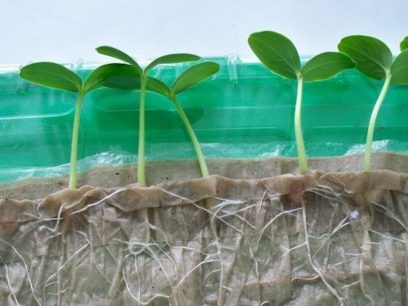
If the gardener did not prepare the land in advance, even in the fall, or forgot to buy it in the store, there is a very simple way to germinate the seeds of vegetables and flowers without land. To do this, you will need:
- food bags or film;
- toilet paper or paper towels;
- tomato seeds.
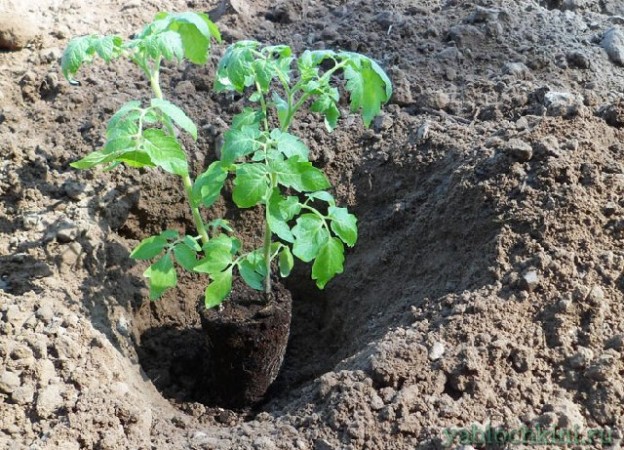 You may be interested in:
You may be interested in:Procedure:
- The usual food bag is folded in half, rib away from you.
- Lay several layers of toilet paper on it, without leaving the edges of the package.
- Prepare a nutrient solution with a rooting agent. 2 drops of epin are added to 500 ml of water, or 20 ml (2 part tablespoons). 3% hydrogen peroxide is diluted in 1 liter of water. Experts believe that the composition of this solution is close to the composition of rainwater during a thunderstorm (water is saturated with oxygen).
- Gathering a solution into the syringe, moisten the paper.
- Tomato seeds are removed from the bags and laid on wet paper, observing a distance of 1 cm from the edge and 1.5-2 cm from each other.
- The paper is again wetted with a solution.
- Roll the bag of seeds into a roll (snail).
- The name of the variety is written on top with a waterproof marker.
- They put on an elastic band for money so that the snail does not turn around.
- Put in a plastic cup. In one small glass, 5 to 10 such diapers (snails) are placed, in which from 50 to 80 seedlings will sprout in a few days.
- Add a nutrient solution to a glass to a height of 1-2 cm
- Top cover with a plastic bag, creating a microparc inside.
- Cleaned for several days in a warm place from (5 to 15 days).
- When loops appear above the surface of the package, the shelter is removed and placed in a bright, but not direct sunlight, warm place.
- After all seeds have sprouted, the temperature is slightly lowered to avoid stretching the senets of the tomato.
- Seedlings are in a cigarette without land until the first true leaves appear, no more than 2-3 weeks, otherwise sprouts can die without food.
- If it is not possible to pick seedlings on time, the snail is unfurled, a little soil is poured on top and gently twisted without pressing. In this state, the plants can be held for another 7-10 days.
- Seedlings ready for diving have a long root; if it rotted or underdeveloped, the sprout is rejected.
Growing in diapers with the ground
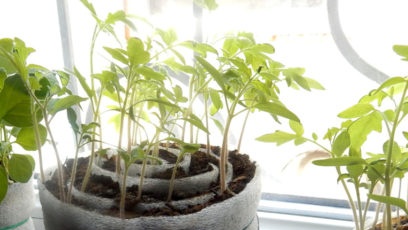
There is another way to grow tomatoes in diapers, but without picking. As a material for a snail, a plastic film or agrospand (spunbond) is used, the principles of twisting, which are slightly different. Film fit:
- A film folded in half about 70 cm long is laid on a table or tray (you can take 2 bags connected together).
- Half the length is laid on moist ground about 1 cm high, the second half remains free.
- Tomato seeds are laid on moist ground, departing from the top about 1-1.5 cm and making a distance between future seedlings of 1.5-2 cm.
- From above, the seeds are slightly sprinkled with earth.
- Twist the snail tightly, starting at the edge with the ground, just wrap the diaper on top with an empty half, helping to maintain its shape.
- Put on an elastic band, sign a grade.
- Put in a container or a cropped plastic bottle. Cover the top with a bag to create a microparc effect.
- When the first shoots appear, the shelter is removed and grown in such diapers until 1-2 true leaves appear.
Landing in a spanbond:
- To make a snail, you need a piece of spunbond of about 25 by 70 cm.
- The material is divided in half in length.
- Wet soil is laid, on one half, departing from the edge of 1-2 cm and not reaching the other edge of about 20 cm.
- Cover the ground with an empty half, aligning along the edge, and wrap the snail.
- Fix it with an elastic band.
- With a toothpick or stick, holes are made on the surface of the earth and seeds are laid in them, watered from a syringe, and sprinkled with soil.
There are several advantages to growing seedlings in a spunbond:
- you don’t need to buy it, use pieces and old torn material that become from the cover of the greenhouse and the greenhouse;
- spanbond breathes, air enters the roots, and the probability of their decay in the cochlea is minimized;
- watering is carried out both from above and from below through a pallet.
Pick of tomato seedlings in diapers
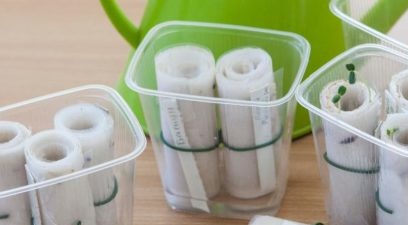
For such a dive, very little land will be needed, which is important for urban residents of high-rise buildings. Work Stages:
- In order not to stain the table with earth, they put a tray on it, on which they put a usual double food bag.
- From any edge (left, right), 2-3 tablespoons are placed on the package. wet ground.
- Unwind a cigarette with seedlings ready for transplanting.
- Remove 1 sprout from the paper, if the spine is too long, it is slightly shortened, so that in the future the root has a branched system. If soaked toilet paper has stuck to the plant, do not remove it; it will dissolve in the future.
- They put the sprout on the ground on seven-leaf leaves and on top cover another 2 tables. tablespoons of earth.
- Carefully, but tightly twist the plant with the earth into the cochlea, starting from the edge where the earth is.
- If desired, the top is fixed with an elastic band or tightly installed in cut-off five-liter bottles.
- As seedlings grow, the diaper is unfurled and 1-2 tablespoons of soil are added.
Care
Care for tomatoes in diapers consists of:
- Glaze. Watering is carried out 1 time in 3-5 days, depending on the drying of the earth coma. Young sprouts are watered from a syringe from above, grown and strong produce through a tray.
- Top dressing.The first time the seedlings are fed two weeks after the pick, then as necessary. if the sprouts are stunted, they are watered with full complex fertilizer, taking a half dose.
- Loosening. They produce with a toothpick, trying not to touch the delicate and thin roots. It is a necessary action after watering, especially when grown in plastic bags. Without air, the roots choke and begin to rot.
- Docs. Growing in diapers entails insufficient illumination of young bushes and elongation of plants.
Landing in the greenhouse
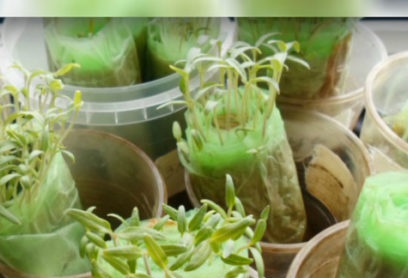
Since these plants lack nutrition, they are planted in the greenhouse as soon as the weather permits. Most often, tomatoes are overgrown due to a lack of light. There are 2 ways to plant a tomato. If seedlings are not overgrown:
- Dig a hole about 20 cm deep. 1-2 tablespoons are put on the bottom. superphosphate, which is a poorly soluble fertilizer in water. When watering, it gradually dissolves and supplies the tomato roots with phosphorus throughout the season. To reduce the acidity of the soil and supply tomatoes with potassium, ½ cup ash and a little humus or compost are added to the hole. All are mixed. Shed with water.
- Expand the diaper. All the earth in it is entangled in the roots of a tomato. The plant is lowered into the hole and covered with earth. Top mulch with hay, peat, compost.
- Arcs are placed on top and covered with lutrasil (spanbond) in order to protect from temperature drops and sunburn.
- After a week, the plants are completely rooted and further care for them is carried out in accordance with the rules for the care of tomatoes.
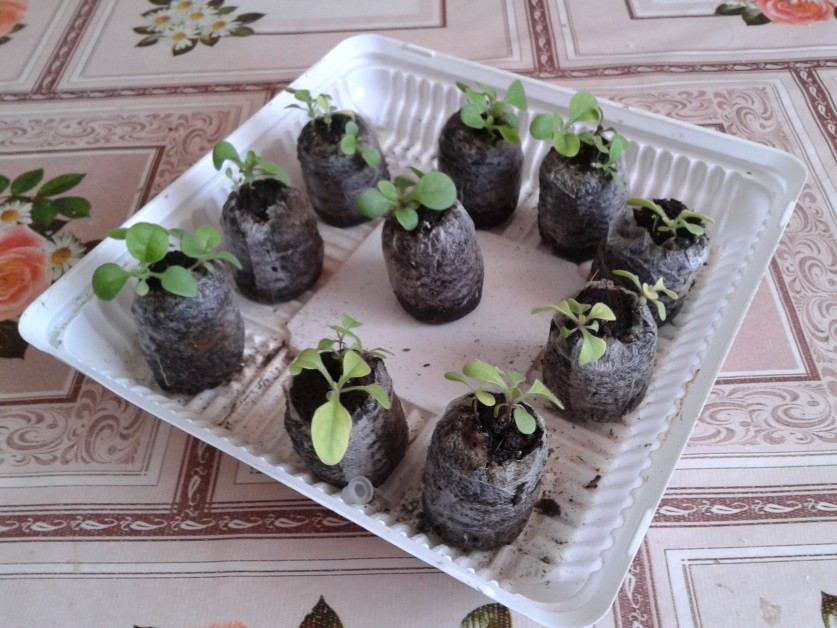 You may be interested in:
You may be interested in:If the seedlings are thin and outgrown:
- They do not dig holes, but grooves with a depth of 10-15 cm, add mineral and organic fertilizers necessary for growth.
- They unroll the diaper without shaking the ground from the roots, lay the plant in a trench with its roots to the south and filling the whole stem with earth, leaving only the crown above the ground.
- Plants cover with lutrasil.
- The crown will reach for the sun and will soon straighten up. in a week the whole plant will take root.
- A peg is placed near the tomato and seedlings are tied to it.
- After 10-14 days, the first top dressing is performed.
It is easy to grow tomato seedlings in diapers if you follow the rules of care and do not forget to add land as the seedling grows. At seedlings during transplantation into greenhouses and hotbeds, roots are not injured, and it quickly takes root in the ground. And the crop obtained subsequently depends on the completeness of care and care of the gardener about tomato bushes.

 Low-growing tomatoes, without pinching: 5 of the most delicious varieties
Low-growing tomatoes, without pinching: 5 of the most delicious varieties Why tomato seedlings grow poorly
Why tomato seedlings grow poorly We grow a tomato in a shell
We grow a tomato in a shell Growing tomatoes without watering according to the method of Kazarin
Growing tomatoes without watering according to the method of Kazarin